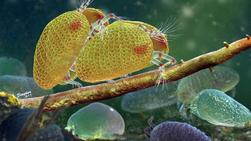 An impression sheds light on the mating behavior of ancient ostracods. (PHOTO / XINHUA)
An impression sheds light on the mating behavior of ancient ostracods. (PHOTO / XINHUA)
A partnership between researchers at Queen Mary University of London and the Nanjing Branch of the Chinese Academy of Sciences has led to the discovery of the world's oldest animal sperm.
The scientists believe the animals were having sex just as they were enveloped by tree resin, which then fossilized into amber sometime in the Cretaceous period
The fossilized sperm was found inside tiny water creatures trapped in amber about 100 million years ago, in what is now Myanmar.
Paleontologists made the find preserved inside a female ostracod, a type of small crustacean that has existed for 450 million years.
The scientists believe the animals were having sex just as they were enveloped by tree resin, which then fossilized into amber sometime in the Cretaceous period.
The study, published in the journal Royal Society Proceedings B, has implications for understanding the evolutionary history of the reproduction process in animals.
Dave Horne, professor of micropaleontology at the London university, said analyses of fossil ostracod shells are hugely informative about past environments and climates, and shed light on "evolutionary puzzles, but exceptional occurrences of fossilized soft parts like this result in remarkable advances in our understanding".
ALSO READ: Research makes sunflower 'waste' profitable
The experts said fossilized sperm samples are exceptionally rare; previously the oldest known examples were 17 million years old.
Fossilized ostracod shells are common and abundant but it is rare to find specimens preserved in ancient amber with their appendages and internal organs intact.
This ostracod specimen belongs to a new species named Myanmarcypris hui, they said. The creatures lived in coastal waters where they became trapped in the blob of resin.
The team at the Chinese Academy of Sciences was able to use X-rays to obtain high-resolution images of the well-preserved soft parts of the ostracods. It found "giant sperm" stored in a pair of sperm receptacles inside the female ostracod, waiting for the eggs to mature.
The discovery was a special "eureka moment", one researcher said.
jonathan@mail.chinadailyuk.com


